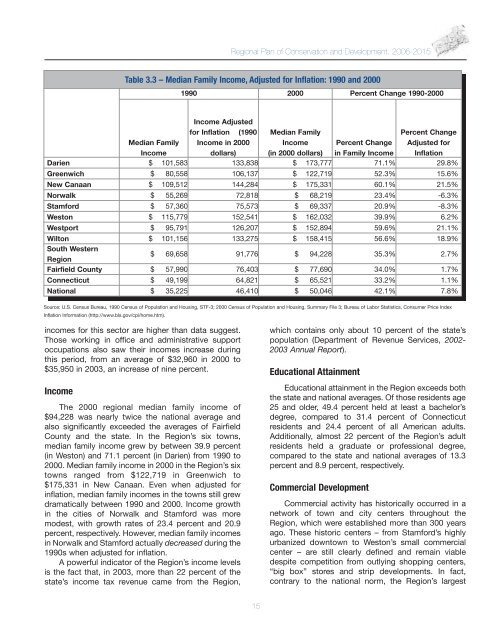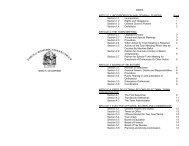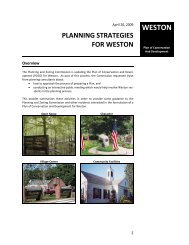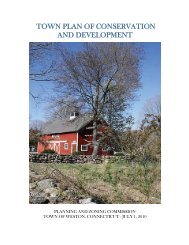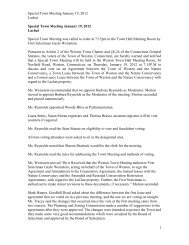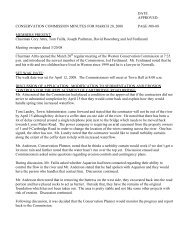Regional Plan of Conservation and Development, 2006-2015
Regional Plan of Conservation and Development, 2006-2015
Regional Plan of Conservation and Development, 2006-2015
Create successful ePaper yourself
Turn your PDF publications into a flip-book with our unique Google optimized e-Paper software.
<strong>Regional</strong> <strong>Plan</strong> <strong>of</strong> <strong>Conservation</strong> <strong>and</strong> <strong>Development</strong>, <strong>2006</strong>-<strong>2015</strong>Table 3.3 – Median Family Income, Adjusted for Inflation: 1990 <strong>and</strong> 20001990 2000 Percent Change 1990-2000Income Adjustedfor Inflation (1990 Median FamilyPercent ChangeMedian FamilyIncomeIncome in 2000dollars)Income(in 2000 dollars)Percent Changein Family IncomeAdjusted forInflationDarien $ 101,583 133,838 $ 173,777 71.1% 29.8%Greenwich $ 80,558 106,137 $ 122,719 52.3% 15.6%New Canaan $ 109,512 144,284 $ 175,331 60.1% 21.5%Norwalk $ 55,269 72,818 $ 68,219 23.4% -6.3%Stamford $ 57,360 75,573 $ 69,337 20.9% -8.3%Weston $ 115,779 152,541 $ 162,032 39.9% 6.2%Westport $ 95,791 126,207 $ 152,894 59.6% 21.1%Wilton $ 101,156 133,275 $ 158,415 56.6% 18.9%South WesternRegion$ 69,658 91,776 $ 94,228 35.3% 2.7%Fairfield County $ 57,990 76,403 $ 77,690 34.0% 1.7%Connecticut $ 49,199 64,821 $ 65,521 33.2% 1.1%National $ 35,225 46,410 $ 50,046 42.1% 7.8%Source: U.S. Census Bureau, 1990 Census <strong>of</strong> Population <strong>and</strong> Housing, STF-3; 2000 Census <strong>of</strong> Population <strong>and</strong> Housing, Summary File 3; Bureau <strong>of</strong> Labor Statistics, Consumer Price IndexInflation Information (http://www.bls.gov/cpi/home.htm).incomes for this sector are higher than data suggest.Those working in <strong>of</strong>fice <strong>and</strong> administrative supportoccupations also saw their incomes increase duringthis period, from an average <strong>of</strong> $32,960 in 2000 to$35,950 in 2003, an increase <strong>of</strong> nine percent.IncomeThe 2000 regional median family income <strong>of</strong>$94,228 was nearly twice the national average <strong>and</strong>also significantly exceeded the averages <strong>of</strong> FairfieldCounty <strong>and</strong> the state. In the Region’s six towns,median family income grew by between 39.9 percent(in Weston) <strong>and</strong> 71.1 percent (in Darien) from 1990 to2000. Median family income in 2000 in the Region’s sixtowns ranged from $122,719 in Greenwich to$175,331 in New Canaan. Even when adjusted forinflation, median family incomes in the towns still grewdramatically between 1990 <strong>and</strong> 2000. Income growthin the cities <strong>of</strong> Norwalk <strong>and</strong> Stamford was moremodest, with growth rates <strong>of</strong> 23.4 percent <strong>and</strong> 20.9percent, respectively. However, median family incomesin Norwalk <strong>and</strong> Stamford actually decreased during the1990s when adjusted for inflation.A powerful indicator <strong>of</strong> the Region’s income levelsis the fact that, in 2003, more than 22 percent <strong>of</strong> thestate’s income tax revenue came from the Region,which contains only about 10 percent <strong>of</strong> the state’spopulation (Department <strong>of</strong> Revenue Services, 2002-2003 Annual Report).Educational AttainmentEducational attainment in the Region exceeds boththe state <strong>and</strong> national averages. Of those residents age25 <strong>and</strong> older, 49.4 percent held at least a bachelor’sdegree, compared to 31.4 percent <strong>of</strong> Connecticutresidents <strong>and</strong> 24.4 percent <strong>of</strong> all American adults.Additionally, almost 22 percent <strong>of</strong> the Region’s adultresidents held a graduate or pr<strong>of</strong>essional degree,compared to the state <strong>and</strong> national averages <strong>of</strong> 13.3percent <strong>and</strong> 8.9 percent, respectively.Commercial <strong>Development</strong>Commercial activity has historically occurred in anetwork <strong>of</strong> town <strong>and</strong> city centers throughout theRegion, which were established more than 300 yearsago. These historic centers – from Stamford’s highlyurbanized downtown to Weston’s small commercialcenter – are still clearly defined <strong>and</strong> remain viabledespite competition from outlying shopping centers,“big box” stores <strong>and</strong> strip developments. In fact,contrary to the national norm, the Region’s largest15


